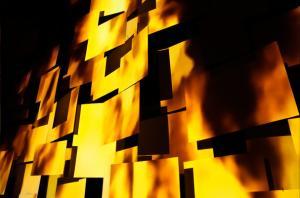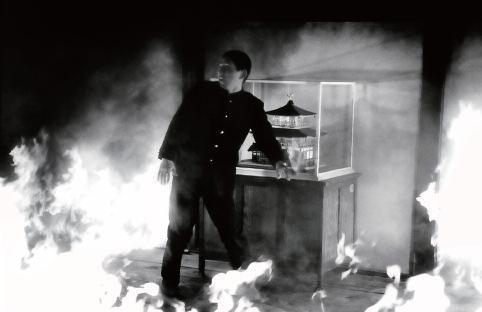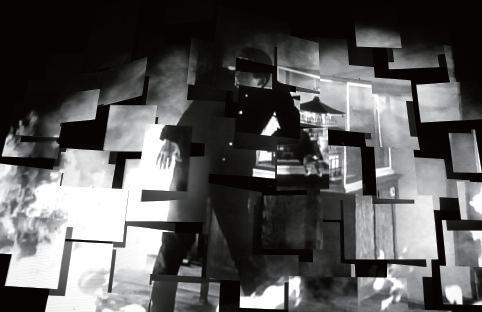The Temple's Fourth Burning
Yuca Ishizuka's 'Golden Pavilion'
By Yoichi Takabayashi
 Yuca Ishizuka's Golden Pavilion
Yuca Ishizuka's Golden Pavilion
More than fifty years ago, an incident took place. The Rokuon Temple (also known as the Temple of the Golden Pavilion), in Kitayama, Kyoto, was burnt down to the ground by a young monk who was studying there. It had been established over six hundred years previously by the Shogun, Ashikaga Yoshimitsu. The Temple of the Golden Pavilion was one of Japan’s major cultural assets and was a designated national treasure that had escaped the ravages of war. It was thought to be everlasting. This act of arson happened at the time when I was a high school student in Kyoto, and I found it deeply shocking. It was not simply the incineration of a building, but the irreparable loss of over six hundred years of history.
“Why did he have to burn down the Golden Pavilion?”
I wanted to look into the darkness within the monk’s mind and understand the lifelong irrationalities that lurked there. Of course, this was a huge event at the time. So many people have produced sociological analyses and psychological interpretations of what happened, turning the event into a social phenomenon of sorts. However, I never felt that any of those works truly grasped the motives buried in his mind.

Some years after the incident author Yukio Mishima wrote the novel ‘The Temple of the Golden Pavilion’, which portrayed the young monk. On reading this work, what struck me even more than the actual incident itself was how the novel brought out the essence of the young monk’s inexplicable act. While being the fiction of the gifted Yukio Mishima, it remained engraved in my mind as a sublime reflection of the truth hidden behind the circumstances of that event.
Later in my life I became involved with film, and within the body of my work, I wanted to create one entitled “The burning down of the Temple of the Golden Pavilion” inspired by Mishima’s novel. I was looking for opportunities to make it happen. That chance came unexpectedly early on in my career and the project was realized by the Art Theatre Guild of Japan film institute. Feeling that my dramatization of Mishima’s novel affirmed an intimation of my deeper self, I rewrote the scenario as far as I could allow myself. By having the actor Saburo Shinoda play the part of the young monk, I felt sure that the film would turn out well. Following its completion, the film immediately went on general release and it was very well received.
Thirty years have passed since then and the film had faded out of people’s memories. However, in April 2006 the Kawasaki City Museum held a screening of nine of my old works, which included “Temple of the Golden Pavilion”. I was contacted by an artist who wanted to reconstruct the arson scene within her art project. It was out of this that Yuca Ishizuka’s “Golden Pavilion” was born.
In September 2006 it premiered among the satellite projects of the Shanghai Biennale, and was showcased as the centerpiece of the Japan Pavilion, where it was a great success. The performance especially held for the opening night–a collaboration she made with a traditional Japanese dancer and a lute player–appealed to the international audience.

Focusing on the moment of the Golden Pavilion burning down, Ishizuka restructured the scene and projected it onto an innovatively designed screen. The speed with which time passes in this climactic scene had been consciously manipulated. While it was indeed a reconstruction of the scene from my film, it should be thought of as coming from Ishizuka’s universe: the magnificent creation of a completely different world.
We take it for granted that, be it screens or cathode ray tubes, moving imagery is projected onto flat, demarcated surfaces. However Yuca Ishizuka’s screen is not flat, but of an almost spherical construction, irregularly composed of fragmentary parts and as a result, the images are intricately broken up, entering a totally unique realm of spatial conception. Furthermore, Yuca Ishizuka has broken with the cinematic principle of using 24 frames per second and reconstructed everything in manipulated time and motion. Thus, the scene from my original film, the nature of which has already been altered by the fragmented screen, is altered yet more bringing it into an entirely new dimension from that of conventional cinematic expression.
The compulsion to burn down the Golden Pavilion, this symbolic act of trying to transfigure the world through beauty, has now been revived in her art work. Even to the tips of the roaring flames, her intensely passionate vision takes on a form that transcends time and space. While this single event occurred over fifty years ago, it burned again in Yukio Mishima’s ‘The Temple of the Golden Pavilion’, it burnt in my film ‘Temple of the Golden Pavilion’; and now, Yuca Ishizuka is making it burn for the fourth time. JI
Translation by Ashley Rawlings
Yoichi Takabayashi
Director, cinematographer, screenwriter and editor.
Born 1931 in Kyoto.
The pioneer of Japanese experimental and independent film. One of his early works, “Ishikkoro”, (1960) made a great impact on avant-garde filmmakers, which won the Gold Prize at the Monticatini International Amateur Film Festival and the Silver Prize at the Salerno International Film Festival in Italy. His commercial success flourished in the 70's with major films like: “Gaki Zoshi” (1972), Grand Prize, International Filmfestival Mannheim- Heidelberg/International Critics’ Week at Cannes Film Festival, “Murder in Honjin Manor House” (1975), Berlin International Film Festival, including “Temple of the Golden Pavilion” (1976), Japanese Ministry of Culture Excellence Award/Minister of Education Newcomers' Award for Fine Arts.
Currently, filming his new work “Hate-eno-Tabi” is in progress.
Yuca Ishizuka
Artist and designer.
Her strong background in photography and video, combined with her insatiable interest in social art drives her deeply into her own style of unconventional art. In recent years, she has been working extensively in diverse cross-disciplinary art projects with leading professionals and experts from various areas including academic field both domestically and overseas. She continuously expands her engagement into unexplored territories where she believes our creative heritage should be equally nurtured, shared and passed on.
Her next solo exhibition will be held June-August this year in Sydney, Australia. This will be a site-specific project on Nushu, a unique writing system that was exclusively used by women in Hunan, China.





